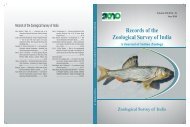Andaman booklet aw.FH10 - Zoological Survey of India
Andaman booklet aw.FH10 - Zoological Survey of India
Andaman booklet aw.FH10 - Zoological Survey of India
You also want an ePaper? Increase the reach of your titles
YUMPU automatically turns print PDFs into web optimized ePapers that Google loves.
Nicobar Scops-Owl Otus alius: The Nicobar Scops-owl is known<br />
only from a single locality on Campbell Bay (Rasmussen 1998). The<br />
species may occur on other islands in the group, but equally it may<br />
be endemic to Great Nicobar, and indeed restricted in range on that<br />
island. The most likely other island where it may be found is Little<br />
Nicobar which, like Great Nicobar, is relatively poorly explored<br />
(Rasmussen 1998).<br />
<strong>Andaman</strong> Black Woodpecker Dryocopus hodgei:This Woodpecker<br />
is Near Threatened species and endemic to the <strong>Andaman</strong> islands,<br />
where it is a common resident in large trees <strong>of</strong> evergreen forest<br />
(Davidar et al., 1996; Grimmett et al., 1998). Although forest remains<br />
fairly extensive on the <strong>Andaman</strong>s, the human population on larger<br />
islands is rising rapidly and habitat is consequently under severe<br />
pressure from agriculture, grazing and logging (Pande et al., 1991;<br />
Stattersfield et al., 1998).<br />
<strong>Andaman</strong> Drongo Dicrurus andamanensis: This Drongo is endemic<br />
to the <strong>Andaman</strong> archipelago also recorded from Coco Island in<br />
Myanmar, where it is a common resident <strong>of</strong> forests (Davidar et al.,<br />
1996; Grimmett et al., 1998). Although its range is very small, forested<br />
habitat is relatively intact on the <strong>Andaman</strong>s and insufficiently<br />
disturbed or fragmented to be <strong>of</strong> immediate concern.<br />
<strong>Andaman</strong> Treepie Dendrocitta bayleyi: This Treepie is Near<br />
Threatened and endemic to the <strong>Andaman</strong> archipelago, where it is<br />
usually found in pairs or parties <strong>of</strong> up to 20 birds, or in mixed flocks<br />
in tall trees in dense broadleaved evergreen forest (Grimmett et al.,<br />
1998).<br />
Importance <strong>of</strong> Protected areas<br />
The protected areas are regarded as cornerstones <strong>of</strong> biodiversity<br />
conservation. Creation <strong>of</strong> a sound network <strong>of</strong> PAs is regarded as the<br />
best and only practical way for in situ conservation <strong>of</strong> biodiversity<br />
in species rich countries (Glowka et al., 1994). The <strong>Andaman</strong> and<br />
22
















